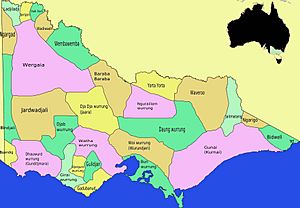Jarijari facts for kids
Jarijari were an Indigenous Australian people who lived in the Mallee region of Victoria, Australia. Their traditional lands were along the Murray River.
Contents
What's in a Name?
The word "Jarijari" was actually the tribe's word for "no." It was common for many Indigenous groups along the Murray River to be known by the word for "no" in their language.
Jarijari Language
The Jarijari language is part of a group called the Lower Murray Areal Group. It was similar to the Kureinji language and also had similarities to the language spoken by the Watiwati people.
Jarijari Country
The Jarijari people's traditional lands covered about 1,900 square miles (4,900 square kilometers). This area was on the western side of the Murray River, stretching from above Chalka Creek down to Annuello in the Mallee region.
Their southern border reached areas like Hopetoun and Lake Korong. To the north, their land bordered Redcliffs.
The Jarijari shared borders with several other Indigenous groups:
- The Wergaia people were to their south.
- The Latjilatji people were to their west.
- The Dadi Dadi people were to their east.
Food from the River
The Jarijari people relied heavily on the Murray River for their food, especially fish. Here are some of the fish they ate:
- Eel-tailed catfish (called kenaru by the Jarijari) was a very special food. Young men were not allowed to eat it.
- Bony bream (called manur by the Jarijari) was a main food source during June and July. However, women were not allowed to eat it. This fish was also used as a grave marker, pointing in the direction of a suspected murderer.
- Silver perch (called baggack) was another important fish.
- Other fish included different types of perch, gudgeon, smelt, and hardyhead.
- Murray cod (called yaturr) was a very important food for the Jarijari, even in winter. They would hunt it at night by firelight when the river flooded and the cod would 'sleep' in logs. In summer, they would dive to the bottom of the Murray River to spear them.
Jarijari History and European Encounters
One of the first detailed meetings between Europeans and the Jarijari people happened during the Blandowski Expedition in 1856-1857. William Blandowski, who led the expedition, called the Jarijari his "good friends." He even created an illustration in 1857 that showed the Jarijari people enjoying traditional games.
Later, in 1883, Peter Beveridge wrote about some of the Jarijari tribe's Dreamtime beliefs. Dreamtime stories are ancient stories that explain the creation of the world and how people should live.
Sadly, Blandowski also wrote about the difficult times for the Indigenous groups along the Murray River. He noted that many areas were becoming empty, which made travelers sad compared to just a few years before. This was due to the impact of European settlement.
Other Names for Jarijari
The Jarijari people were also known by several other names, including:
- Jere jere
- Nyerri-nyerri
- Yairy-yairy
- Yari-yari
- Yariki-luk (a name given to them by the Wotjobaluk)
- Yarree Yarree, Yarre-yarre, Yerri-yerri, Yerre-yerre, Yerry-yerry
Some Jarijari Words
- yaturr (Murray cod)
- barnta (Trout cod)


